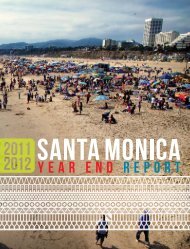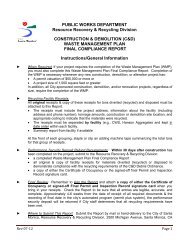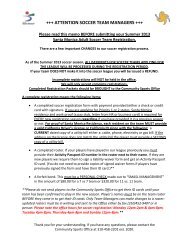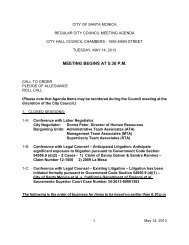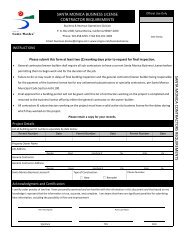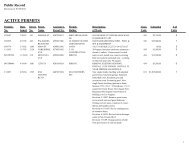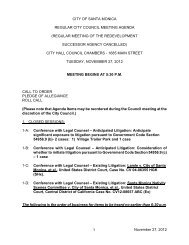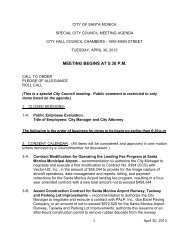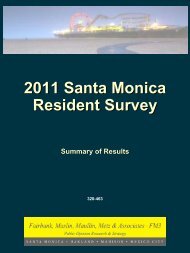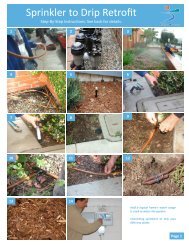Water Quality rePOrt - City of Santa Monica
Water Quality rePOrt - City of Santa Monica
Water Quality rePOrt - City of Santa Monica
Create successful ePaper yourself
Turn your PDF publications into a flip-book with our unique Google optimized e-Paper software.
<strong>City</strong> <strong>of</strong> <strong>Santa</strong> <strong>Monica</strong> <strong>Water</strong> Division<br />
Annual<br />
<strong>Water</strong> <strong>Quality</strong> REPORT<br />
JUNE 2012<br />
Important Information<br />
And Tips on <strong>Water</strong> <strong>Quality</strong><br />
AND Safety<br />
http://waterquality.smgov.net
Dear <strong>Santa</strong> <strong>Monica</strong> Residents,<br />
In recent years we’ve informed you <strong>of</strong> progress in restoring our<br />
local groundwater supply and the constant vigilance the <strong>City</strong><br />
maintains to ensure the safety and acceptability <strong>of</strong> our drinking<br />
water. Did you know the <strong>City</strong> owns and operates a State-certified<br />
water quality testing laboratory, and more than 10,000 water<br />
samples are collected in this city and tested every year? It’s easy<br />
to take for granted that pleasant tasting, clean drinking water is<br />
available at the touch <strong>of</strong> a faucet; in reality there’s a lot <strong>of</strong> hard<br />
work involved in getting the water to your tap.<br />
<strong>Water</strong> <strong>Quality</strong><br />
Is Everybody’s Business<br />
Environmental awareness extends beyond the air we breathe<br />
and food we eat. Citizens across the country have asked to be<br />
kept informed about the quality <strong>of</strong> their water. In response,<br />
Congress and the California Legislature have passed laws that<br />
require water agencies to provide an annual water quality<br />
report to their customers.<br />
This report gives an overview <strong>of</strong> how the <strong>City</strong> <strong>of</strong> <strong>Santa</strong> <strong>Monica</strong><br />
Public Works/<strong>Water</strong> Resources Division provides your tap<br />
water and explains the many steps we take to ensure the<br />
quality and safety <strong>of</strong> our water.<br />
If you require this report in an alternate format, please call us<br />
at (310) 826-6712 or email myriam.cardenas@smgov.net<br />
Este informe contiene informacion muy importante sobre<br />
su agua potable. Traduzcalo o hable con alguien que lo<br />
entienda bien..<br />
Over the past year, we’ve returned to producing more local<br />
groundwater than we have in the last 16 years. However, we’re<br />
not done yet. We are working to develop additional groundwater<br />
production capabilities as part <strong>of</strong> an ambitious goal to achieve<br />
water self-sufficiency by the end <strong>of</strong> this decade (ending the<br />
<strong>City</strong>’s need to purchase imported water from the Sacramento-<br />
San Joaquin Delta or the Colorado River). We’re studying the<br />
local groundwater basins in search <strong>of</strong> additional water supplies.<br />
Furthermore, we’re investigating the enhanced use <strong>of</strong> recycled<br />
water and rain water capture for irrigation uses as ways to reduce<br />
the amount <strong>of</strong> potable water presently used for these purposes.<br />
Nevertheless, self-sufficiency won’t come through additional<br />
supply alone. Conservation remains as important as ever, and we<br />
urge all residents and businesses throughout the city to continue<br />
to maintain your high standards for water conservation which<br />
make <strong>Santa</strong> <strong>Monica</strong> a model <strong>of</strong> environmental stewardship and<br />
sustainability. <strong>Water</strong>-wise, climate-appropriate landscaping,<br />
the use <strong>of</strong> water-efficient appliances, and prompt repair <strong>of</strong> leaky<br />
fixtures are among the easiest and most painless ways to lower<br />
your water use.<br />
Keep drinking the tap water, <strong>Santa</strong> <strong>Monica</strong>, and to learn more<br />
ways to reduce your water consumption visit www.sustainablesm.<br />
org/water.<br />
Sincerely,<br />
Gil Borboa<br />
Gil Borboa<br />
<strong>Water</strong> Resources Manager
Producing Great Tasting<br />
Good <strong>Quality</strong> <strong>Water</strong><br />
<strong>Santa</strong> <strong>Monica</strong>’s<br />
<strong>Water</strong> Treatment Works<br />
The <strong>City</strong>’s new treatment plant has been online for more than<br />
a year now and has been producing good quality and great<br />
tasting water every day.<br />
The water that is treated and eventually pumped to homes<br />
and businesses in <strong>Santa</strong> <strong>Monica</strong> originates as groundwater in<br />
and around <strong>Santa</strong> <strong>Monica</strong>. The majority <strong>of</strong> the groundwater<br />
comes from the Charnock Well Field, which has been used as a<br />
drinking water source for <strong>Santa</strong> <strong>Monica</strong> since 1924.<br />
The well field was shut down for several years when testing<br />
revealed that the gasoline additive, Methyl tert-Butyl Ether<br />
(MTBE) had infiltrated the aquifer supplying the wells.<br />
The source <strong>of</strong> the gasoline compound was leakage from<br />
underground storage tanks at gasoline service stations in the<br />
vicinity. The <strong>City</strong> <strong>of</strong> <strong>Santa</strong> <strong>Monica</strong> pursued restitution and<br />
eventually reached a settlement agreement with the principal<br />
responsible parties to remediate and restore the well field as a<br />
drinking water source.<br />
The Charnock Well Field Restoration Project culminated in<br />
the reactivation <strong>of</strong> the well field and the launching <strong>of</strong> the new<br />
treatment plant in December 2010. A primary component <strong>of</strong><br />
the treatment works is the Granular Activated Carbon (GAC)<br />
filtration system, which removes MTBE and another potential<br />
gasoline additive, tert-Butyl Alcohol (TBA) contamination in<br />
the groundwater at the Charnock Well Field.<br />
The water from the Charnock Well Field is then combined<br />
with the flow from other wells and delivered to the <strong>City</strong>’s main<br />
treatment facility in West Los Angeles where it undergoes a<br />
5 step process to reduce any remaining contaminants and<br />
achieve drinking water quality.<br />
A major component <strong>of</strong> the treatment facility is the Reverse<br />
Osmosis (RO) s<strong>of</strong>tening system and the final adjustments<br />
including fluoridation and disinfection. S<strong>of</strong>tening is the<br />
process <strong>of</strong> removing scale-forming calcium and magnesium<br />
from hard water. Reverse Osmosis (RO) is a method <strong>of</strong><br />
s<strong>of</strong>tening that separates the scale-forming minerals by forcing<br />
hard water through membranes with very small pores.<br />
The complete treatment process is outlined on the following<br />
pages.<br />
This facility is currently producing 52% <strong>of</strong> the water utilized<br />
by <strong>Santa</strong> <strong>Monica</strong> with the capability <strong>of</strong> producing 70% <strong>of</strong> the<br />
water supplied to the city. This greatly reduces our reliance<br />
on imported water obtained through the Metropolitan <strong>Water</strong><br />
District. For more information about the new treatment<br />
facilities, please call the plant staff at (310) 826-6712.
<strong>Santa</strong> <strong>Monica</strong><br />
<strong>Water</strong> Treatment Process<br />
CHARNOCK WELL FIELD<br />
Charnock Wells<br />
Groundwater contaminated<br />
with the gasoline additive<br />
MTBE is pumped up from 400<br />
feet below ground surface.<br />
Greensand Filtration<br />
The well water is filtered<br />
through greensand media to<br />
remove iron and manganese<br />
which would foul the<br />
carbon filters.<br />
GAC Filtration<br />
The MTBE is removed by<br />
filtering through Granular<br />
Activated Carbon<br />
(GAC) filters.<br />
Pump to Treatment Plant<br />
The filtered water is combined<br />
with the flow <strong>of</strong> other wells<br />
and pumped to the <strong>Santa</strong><br />
<strong>Monica</strong> <strong>Water</strong> Treatment<br />
Plant.<br />
<strong>Santa</strong> <strong>Monica</strong><br />
water<br />
Treatment<br />
Plant<br />
Pretreatment<br />
To protect the sensitive Reverse Osmosis (RO) filters, the combined well flow is filtered again<br />
through greensand and cartridge filters to remove more<br />
iron, manganese and any remaining sediment.<br />
Reverse Osmosis<br />
Filtration<br />
<strong>Water</strong> <strong>Quality</strong><br />
Adjustments<br />
The mineral content is adjusted to the desired<br />
s<strong>of</strong>tness. The pH is adjusted, fluoride<br />
is added and the water undergoes final<br />
disinfection with chloramine.<br />
Reverse Osmosis Filtration<br />
Filtration through a three-stage Reverse Osmosis<br />
(RO) membrane system s<strong>of</strong>tens the water by removing minerals<br />
(calcium and magnesium). RO uses pressure to force water through<br />
membranes with pores so small the minerals can’t pass through.<br />
Aeration and Storage<br />
The final step, aeration, uses the existing<br />
air stripping technology in the five million gallon<br />
reservoir to remove any remaining volatile<br />
groundwater contaminants<br />
such as trichloroethene (TCE).<br />
Final Delivery<br />
<strong>Santa</strong> <strong>Monica</strong> residents and businesses receive water<br />
for everyday use. <strong>Water</strong> conservation by end users is<br />
key to ensuring water reliability and sustainability.
Ensuring the Safety <strong>of</strong><br />
<strong>Santa</strong> <strong>Monica</strong>’s <strong>Water</strong> Supply<br />
Our drinking water meets or exceeds all State and Federal<br />
water quality requirements. The safety <strong>of</strong> <strong>Santa</strong> <strong>Monica</strong>’s<br />
drinking water supply is <strong>of</strong> paramount importance.<br />
More than 10,000 water quality tests are conducted each<br />
year at <strong>Santa</strong> <strong>Monica</strong>’s State-certified laboratory by qualified<br />
chemists and technicians to ensure the safety <strong>of</strong> the city’s<br />
supply. The <strong>City</strong> <strong>of</strong> <strong>Santa</strong> <strong>Monica</strong> Public Works/<strong>Water</strong><br />
Resources Division expends considerable resources keeping its<br />
water treatment system up to date and performing properly.<br />
Drinking water, including bottled water, may reasonably<br />
be expected to contain at least small amounts <strong>of</strong> some<br />
contaminants. Their presence does not necessarily<br />
indicate that water poses a health risk. More information<br />
about contaminants and potential health effects can be<br />
obtained by calling the EPA Safe Drinking <strong>Water</strong> Hotline<br />
at (800) 426-4791.<br />
Sources <strong>of</strong> <strong>Water</strong><br />
The sources <strong>of</strong> drinking water (both tap and bottled) include<br />
rivers, lakes, streams, ponds, reservoirs, springs and wells.<br />
As water travels over the surface <strong>of</strong> the land or through the<br />
ground, it dissolves naturally occurring minerals and can pick<br />
up substances resulting from the presence <strong>of</strong> animals or from<br />
human activity. Contaminants that may be present in source<br />
water before it is treated include:<br />
• Microbial contaminants such as viruses and bacteria, which<br />
may come from sewage systems, septic tanks, agricultural<br />
livestock operations and wildlife.<br />
• Inorganic contaminants such as salts and metals, which<br />
can be naturally occurring or result from urban stormwater<br />
run<strong>of</strong>f, industrial or domestic wastewater discharges, oil<br />
and gas production, mining or farming.**<br />
• Pesticides and herbicides, which may come from a variety<br />
<strong>of</strong> sources such as agriculture and residential uses.<br />
• Radioactive contaminants, which are naturally occurring.<br />
• Organic chemical contaminants including synthetic<br />
and volatile organic chemicals, which are by-products <strong>of</strong><br />
industrial processes and petroleum production and can also<br />
come from gas stations, urban stormwater run<strong>of</strong>f and septic<br />
systems.<br />
In order to ensure that tap water is safe to drink, USEPA and<br />
the California Department <strong>of</strong> Public Health (DPH) prescribe<br />
limits on certain contaminants in water provided by public<br />
water systems. DPH regulations also establish limits for contaminants<br />
in bottled water to provide the same protection for<br />
public health.<br />
** You can help protect the purity <strong>of</strong> source water by helping control<br />
what goes into the storm drain and water table: Reduce use <strong>of</strong><br />
hazardous products, clean up after pets, recycle used motor oil,<br />
sweep walks and alleys instead <strong>of</strong> hosing. Call (310) 458-8532 to<br />
report storm drain pollution and (310) 458-2255 for information<br />
on alternatives to toxic cleaning products and pesticides.
Our Treated <strong>Water</strong><br />
<strong>Santa</strong> <strong>Monica</strong> has had to rely on imported water sources for<br />
more than 85% <strong>of</strong> our supply in recent years. However, with the<br />
recent restoration <strong>of</strong> the Charnock Well Field and continued<br />
water conservation, we can reduce the demand for imported<br />
water to 30% <strong>of</strong> our needs for the coming years.<br />
The imported water we consume is purchased from the<br />
Metropolitan <strong>Water</strong> District (MWD). MWD provides<br />
supplemental water to about 300 cities and unincorporated<br />
areas in Southern California, importing water from two<br />
separate sources. Colorado River water is delivered from Lake<br />
Havasu by means <strong>of</strong> a 242-mile-long aqueduct. This water<br />
originates as snowmelt from mountainous regions <strong>of</strong> Utah,<br />
Wyoming and Colorado. MWD also distributes State Project<br />
water from the Sacramento-San Joaquin Delta and delivers it to<br />
Southern California by means <strong>of</strong> the 441-mile-long California<br />
Aqueduct. <strong>Water</strong> from the aqueducts is filtered at MWD’s six<br />
modern treatment plants, using chloramine for disinfection.<br />
In 2002, MWD completed a source water assessment <strong>of</strong> its<br />
Colorado and State Project supplies. Colorado River supplies<br />
are considered to be most vulnerable to recreation, urban/storm<br />
water run<strong>of</strong>f, increasing urbanization in the watershed and<br />
wastewater. State Project supplies are considered to be most<br />
vulnerable to urban/storm water run<strong>of</strong>f, wildlife, agriculture,<br />
recreation and wastewater. A copy <strong>of</strong> the assessment can be<br />
obtained by contacting MWD at (213) 217-6850.<br />
About the<br />
Tables<br />
<strong>Santa</strong> <strong>Monica</strong>’s water supply undergoes constant, rigorous<br />
testing at the <strong>Water</strong> Treatment Plant by plant operators and<br />
chemists at our <strong>Water</strong> <strong>Quality</strong> Laboratory. Permission and<br />
oversight to operate a community water system is granted<br />
by the California Department <strong>of</strong> Public Health and the U.S.<br />
Environmental Protection Agency. <strong>Santa</strong> <strong>Monica</strong> has a perfect<br />
compliance record in regards to water quality.<br />
The next few pages summarize the past year’s results for the<br />
tests we are required to perform to satisfy Federal and State<br />
regulations for our local well water as well as the water we<br />
import. However, testing the water coming out <strong>of</strong> the treatment<br />
plant is not enough. We also test the water at 100 locations<br />
throughout the city each month to ensure the quality.<br />
The results are presented in two sections- Primary Drinking<br />
<strong>Water</strong> <strong>Quality</strong> Results and Secondary Drinking <strong>Water</strong> <strong>Quality</strong><br />
Results. The Primary Results are for the tests we perform<br />
for contaminants that may affect the public’s health. These<br />
contaminants include hazardous chemicals, metals, bacteria,<br />
and radioactivity. <strong>Santa</strong> <strong>Monica</strong>’s water is below permissible<br />
Maximum Contaminant Levels (MCL) for all contaminants.<br />
The Secondary Results are for the tests we perform for<br />
parameters that may affect the aesthetics <strong>of</strong> the water such<br />
as taste, appearance, and odor. These parameters include<br />
turbidity, minerals, and pH among others. Again, <strong>Santa</strong><br />
<strong>Monica</strong>’s water meets all regulatory requirements for these<br />
parameters.<br />
For questions regarding water quality, call the <strong>Water</strong> <strong>Quality</strong><br />
Laboratory staff at (310) 826-6712.
<strong>City</strong> <strong>of</strong> <strong>Santa</strong> <strong>Monica</strong> <strong>Water</strong> Division<br />
Summary <strong>of</strong> Results for Primary Drinking <strong>Water</strong> Standards for 2011<br />
LOCAL IMPORTED IMPORTED Dates Meets MAJOR SOURCES<br />
PHG/ State WELL WATER SM WELL #1(a) SURFACE WATER SURFACE WATER Sampled Std IN DRINKING WATER<br />
Parameter [MCLG]/ MCL/ Arcadia Plant Weymouth Plant Jensen Plant if other<br />
{MRDLG} {MRDL} Average Range Average Range Average Range Average Range than 2011(b)<br />
Primary Drinking <strong>Water</strong> Standards (Mandatory Health-Related Standards)<br />
Clarity<br />
Maximum Turbidity (NTU) NS 95%
<strong>City</strong> <strong>of</strong> <strong>Santa</strong> <strong>Monica</strong> <strong>Water</strong> Division<br />
Summary <strong>of</strong> Results for Secondary Drinking <strong>Water</strong> Standards for 2011<br />
LOCAL IMPORTED IMPORTED<br />
PHG/ State WELL WATER SM WELL #1(a) SURFACE WATER SURFACE WATER<br />
Parameter [MCLG] MCL Arcadia Plant Weymouth Plant Jensen Plant<br />
Average Range Average Range Average Range Average Range<br />
Secondary Drinking <strong>Water</strong> Standards (Aesthetic Standards)<br />
Chemical Parameters<br />
Chloride (ppm) NS 500 23 19 - 26 103 101 - 106 70 63 - 76 64 59 - 69 Y Run<strong>of</strong>f/leaching from natural deposits; industrial wastes<br />
Color (units) NS 15
Source <strong>Water</strong><br />
Vulnerability Assessments<br />
The California Department <strong>of</strong> Public Health (DPH) completed<br />
Source <strong>Water</strong> Assessments on <strong>Santa</strong> <strong>Monica</strong> Wells #1, #3<br />
and #4 in 2001 (a summary follows). The assessments<br />
are a requirement for water utilities nationwide and serve<br />
to evaluate the vulnerability <strong>of</strong> all water sources used for<br />
drinking water to “possible contaminating activities“, which<br />
include a wide range <strong>of</strong> everyday activities in addition to<br />
those commonly associated with contamination. For more<br />
information or to see a copy <strong>of</strong> the report, contact the <strong>Water</strong><br />
Resources Division <strong>of</strong>fice at (310) 826-6712.<br />
<strong>Santa</strong> <strong>Monica</strong> Wells # 3 and #4, located mid-city, and Arcadia<br />
Wells #4 and #5, located in West L.A. and assessed in 2000, are<br />
considered most vulnerable to the following activities based<br />
on proximity and analysis <strong>of</strong> the water:<br />
Automobile gas stations<br />
Chemical/petroleum processing/storage<br />
Historic waste dumps/landfills<br />
Known contamination plumes<br />
Landfills/dumps<br />
Automobile repair shops<br />
Fleet/truck/bus terminals<br />
Utility station maintenance areas<br />
Machine shops<br />
Automobile body shops<br />
Hardware/lumber/parts stores<br />
Parks<br />
Apartments and condominiums<br />
Office buildings and complexes<br />
Schools<br />
Facts about Cryptosporidium<br />
In recent years, a microscopic organism called<br />
Cryptosporidium has been found in surface waters across the<br />
country. Cryptosporidium can also be transmitted through<br />
contaminated food or direct contact with human or animal<br />
waste. The organism can cause a gastrointestinal illness if<br />
ingested.<br />
Today’s water treatment plants are capable <strong>of</strong> removing<br />
these organisms when present, but 100% elimination<br />
cannot be guaranteed. Therefore, a very slight chance<br />
<strong>of</strong> contracting the organism remains. Much research is<br />
underway to determine the best way to upgrade treatment<br />
plants to improve protection. Our supplier <strong>of</strong> surface water,<br />
MWD, maintains an aggressive program to detect and<br />
remove Cryptosporidium from the water it delivers to <strong>Santa</strong><br />
<strong>Monica</strong>.<br />
Cryptosporidium need not be a concern for healthy people;<br />
however, others may be more vulnerable to contaminants<br />
in drinking water. Immuno-compromised persons such<br />
as cancer patients undergoing chemotherapy, individuals<br />
who have undergone organ transplants, those with HIV/<br />
AIDS or other immune system disorders, some elderly and<br />
infants can particularly be at risk from infections. These<br />
people should seek advice about drinking water from<br />
their health care providers. USEPA/Centers for Disease<br />
Control guidelines on appropriate means to lessen the<br />
risk <strong>of</strong> infection by Cryptosporidium and other microbial<br />
contaminants are available from the USEPA Safe Drinking<br />
<strong>Water</strong> Hotline (800) 426-4791.<br />
<strong>Santa</strong> <strong>Monica</strong> Well #1, located on the north side, Wells #3 and<br />
#4 and the Arcadia Wells are considered most vulnerable by<br />
their proximity to sewer collection systems, although analyses<br />
have detected no related contamination.
Answers to the Most<br />
Commonly Asked Questions<br />
About Your Tap <strong>Water</strong><br />
What Affects the<br />
Taste <strong>of</strong> My <strong>Water</strong>?<br />
The taste <strong>of</strong> drinking water is<br />
affected by its mineral content as<br />
well as the presence <strong>of</strong> chlorine,<br />
which is used to protect against<br />
potential bacterial contamination.<br />
Sometimes plumbing can cause a<br />
metallic flavor, especially if the water<br />
has been sitting in the pipes for<br />
many hours. Taste, however, does<br />
not necessarily indicate a higher or<br />
lower degree <strong>of</strong> water quality.<br />
How Does My Plumbing<br />
Affect the <strong>Quality</strong> <strong>of</strong> My <strong>Water</strong>?<br />
Plumbing is unlikely to degrade the quality <strong>of</strong> your water. If<br />
your plumbing is old, you may see a discoloration for a few<br />
moments after turning on your tap. This is caused by corrosion<br />
<strong>of</strong> iron or copper pipes, depending on your plumbing, and is<br />
generally not considered harmful. More serious pipe corrosion<br />
will be evident as leaks and breaks start to occur.<br />
What about Lead from My Plumbing?<br />
If your home plumbing contains lead, it could possibly<br />
leach into your water as a result <strong>of</strong> corrosion. Fortunately,<br />
the minerals in our water help to protect against pipe<br />
corrosion, greatly reducing the potential <strong>of</strong> lead entering<br />
the water. These minerals form a film called “scale” that<br />
prevents water from coming into direct contact with home<br />
plumbing.<br />
If present however, elevated levels <strong>of</strong> lead can cause serious<br />
health problems, especially for pregnant women and young<br />
children. Lead in drinking water is primarily from materials<br />
and components associated with service lines and home<br />
plumbing. The <strong>City</strong> <strong>of</strong> <strong>Santa</strong> <strong>Monica</strong> <strong>Water</strong> Resources<br />
Division is responsible for providing high quality drinking<br />
water, but cannot control the variety <strong>of</strong> materials used in<br />
plumbing components. When your water has been sitting<br />
for several hours, you can minimize the potential for lead<br />
exposure by flushing your tap for 30 seconds to 2 minutes<br />
before using water for drinking or cooking. If you are<br />
concerned about lead in your water, you may wish to have<br />
your water tested. Information on lead in drinking water,<br />
testing methods, and steps you can take to minimize exposure<br />
is available from the EPA Safe Drinking <strong>Water</strong> Hotline at<br />
(800) 426-4791 or at www.epa.gov/safewater/lead.<br />
Why Do I Sometimes See<br />
Black, Greasy Particles in My Tub or Sink?<br />
The soot-like particles usually come from black rubber gaskets<br />
and/or linings <strong>of</strong> certain flexible hoses used to connect appliances<br />
to a home’s water supply. As the rubber ages, it starts to<br />
break down and small pieces can break <strong>of</strong>f in a fast flow, as<br />
when a tub faucet is opened all the way. The most common<br />
location to find a degrading hose is on the outlet <strong>of</strong> the water<br />
heater.
What is Chromium 6<br />
And should I be Concerned?<br />
Hexavalent chromium also known as Chromium 6, has been in<br />
the news lately following a report in late 2010 that it was detected<br />
in the drinking water <strong>of</strong> 31 cities across the country. Recently<br />
the California EPA instituted a Public Health Goal (PHG) <strong>of</strong> 0.02<br />
ppb for Chromium 6. The new PHG for Chromium 6 will serve<br />
as guidance for the California Department <strong>of</strong> Public Health in<br />
developing the nation’s first drinking water standard specifically<br />
for Chromium 6 in the future.<br />
Although Chromium 6 is found in industrial processes, it also<br />
occurs naturally in groundwater. For the past decade, the <strong>Water</strong><br />
<strong>Quality</strong> staff has been monitoring the naturally-occurring levels<br />
<strong>of</strong> Chromium 6 in the city’s groundwater wells. Additionally, <strong>City</strong><br />
staff is tracking the development <strong>of</strong> a drinking water standard for<br />
Chromium 6 closely and will continue their current monitoring<br />
program that includes testing <strong>of</strong> our treated water per recent<br />
recommendations from EPA.<br />
Do I Really Need to Buy a<br />
<strong>Water</strong> Filter or Home<br />
Treatment System?<br />
The decision to buy a water<br />
filter or home treatment<br />
system is a matter <strong>of</strong> personal<br />
preference. Our water meets or<br />
exceeds rigid state and federal<br />
health standards. If you decide<br />
to buy a filter or system, be a<br />
smart shopper and do some<br />
homework. Any treatment device you buy should be<br />
registered with the National Sanitation Foundation (NSF).<br />
There are several system types designed to do different<br />
things. Information on treatment systems can be obtained<br />
at www.ConsumerReports.org, or from NSF.<br />
Contact NSF toll free at<br />
(877) 867-3435<br />
or visit www.nsf.org<br />
What about Bottled <strong>Water</strong>?<br />
Again, the decision is yours. You may find that keeping<br />
a pitcher in your refrigerator is a low-cost, water-thrifty<br />
alternative to buying more expensive bottled water, and it’s far<br />
better for the environment. Even when the bottle is reused or<br />
recycled, the petrochemicals used in creating the bottle and<br />
the transportation <strong>of</strong> the water has a significant impact on the<br />
environment - and your wallet.<br />
For now, customers should be aware that California already has<br />
a limit for Total Chromium in drinking water <strong>of</strong> 50 ppb and that<br />
all <strong>of</strong> the water sources for <strong>Santa</strong> <strong>Monica</strong> fall below this limit.<br />
Further, the city’s new Reverse Osmosis facilities are already<br />
providing added protection by reducing the level <strong>of</strong> naturaloccurring<br />
Chromium 6 from our ground water.
<strong>Water</strong>-Self Sufficiency Goal<br />
Currently, the city uses an average <strong>of</strong> 12 million gallons a day,<br />
but can only produce 8.5 million gallons a day. The additional<br />
water needed is purchased and delivered from Northern<br />
California or the Colorado River. The <strong>City</strong> Council has set<br />
a goal <strong>of</strong> water self-sufficiency by 2020, so in order to close<br />
this gap between demand and production, we need to save<br />
water. The <strong>City</strong> is working on a <strong>Water</strong> Self-Sufficiency Plan to<br />
implement programs and activities to achieve the goal <strong>of</strong> water<br />
self-sufficiency. The plan will be available for public comment<br />
in 2013. In the meantime, here are some simple ways you can<br />
conserve water and comply with <strong>Santa</strong> <strong>Monica</strong>’s conservation<br />
regulations:<br />
• Only use sprinklers before 10 am and after 4 pm any day<br />
<strong>of</strong> the week. Adjust your sprinkler controller each season.<br />
Go to www.lacoastalgardens.com to find out how much<br />
water your garden needs and when to water. Even better,<br />
convert sprinklers to a drip irrigation system, install a rain<br />
barrel, or invest in sustainable landscaping. Rebates and<br />
grants up to $5,000 may be available!<br />
• Don’t allow irrigation water to overspray or run<strong>of</strong>f your<br />
property and never use a hose or a leaf blower to clean<br />
driveways, sidewalks, patios, streets, or alleys.<br />
• Replace old toilets, showerheads, and clothes washers with<br />
high-efficiency models and repair all leaking fixtures on<br />
your property.<br />
• Turn <strong>of</strong>f water when brushing teeth or shaving and only<br />
wash full loads <strong>of</strong> laundry.<br />
Where Can I Get More Information?<br />
<strong>City</strong> <strong>of</strong> <strong>Santa</strong> <strong>Monica</strong> <strong>Water</strong> Utility Offices:<br />
<strong>Water</strong> <strong>Quality</strong>....................................................(310) 826-6712<br />
24 hr <strong>Water</strong> Emergencies.................................(310) 826-6712<br />
<strong>Water</strong> Conservation...........................................(310) 458-8972<br />
Billing Office.....................................................(310) 458-8224<br />
Visit our website:<br />
www.smgov.net/departments/publicworks/water.aspx<br />
<strong>Santa</strong> <strong>Monica</strong> <strong>City</strong> Council Meetings:<br />
2nd & 4th Tuesdays <strong>of</strong> each month<br />
Council Chamber<br />
1685 Main Street, <strong>Santa</strong> <strong>Monica</strong><br />
www.smgov.net/cityclerk/council<br />
Metropolitan <strong>Water</strong> District <strong>of</strong> Southern California<br />
(213) 217-6850<br />
www.mwdh2o.com<br />
California Department <strong>of</strong> Public Health<br />
Division <strong>of</strong> Drinking <strong>Water</strong> and Environmental Management<br />
(818) 551-2004<br />
www.cdph.ca.gov/certlic/drinkingwater<br />
U.S. Environmental Protection Agency<br />
Office <strong>of</strong> Ground <strong>Water</strong> & Drinking <strong>Water</strong><br />
(800) 426-4791 - Safe Drinking <strong>Water</strong> Hotline<br />
www.epa.gov/safewater/dwhealth.html<br />
www.water.epa.gov/drink/guide<br />
To learn more on<br />
reducing your<br />
water use visit<br />
www.sustainablesm.org<br />
or call (310) 458-8972.
This brochure is printed<br />
with vegetable-based<br />
inks on paper made<br />
from recycled paper.<br />
CITY OF SANTA MONICA<br />
Department <strong>of</strong> Public Works<br />
WATER DIVISION<br />
P.O. Box 2200<br />
1685 Main Street<br />
<strong>Santa</strong> <strong>Monica</strong>, CA 90406-2200<br />
PRSRT STD<br />
U.S. POSTAGE<br />
PAID<br />
Permit No. 222<br />
<strong>Santa</strong> <strong>Monica</strong>, CA





